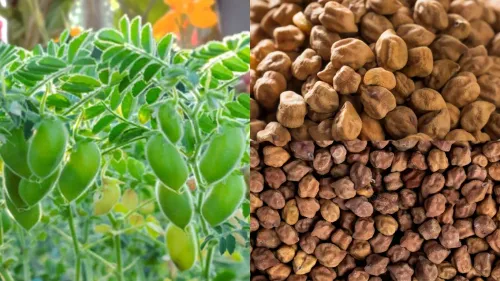High-Yield Gram Variety: Pusa Chana 20211 (Pusa Manav)

0 Views
Updated On:
Pusa Chana 20211 (Pusa Manav) is a high-yield, disease-resistant gram variety offering up to 32.9 quintals per hectare.

Key Highlights
- High yield up to 32.9 quintals per hectare
- Matures in 108 days
- Resistant to Fusarium wilt
- 18.9% protein content
- Suitable for irrigated and timely sown conditions
With the Rabi season in full swing, farmers are gearing up for the sowing of crops like pulses and oilseeds. The Indian government is actively promoting the cultivation of improved crop varieties to boost production. One such crop gaining attention is a new gram variety, Pusa Chana 20211 Desi (also known as Pusa Manav), developed by the Indian Agricultural Research Institute (IARI). This variety offers an impressive yield of up to 32.9 quintals per hectare, making it a cost-effective and high-yielding option for farmers.
Also Read: Govt Increases MSP for Rabi Crops 2025-26: Mustard and Rapeseed Get the Highest Boost
Key Features of Pusa Chana 20211 (Pusa Manav) Gram
- Released in 2021: This gram variety was introduced by the Central Variety Release Committee and is particularly suited for Central India, including Gujarat, Maharashtra, and Madhya Pradesh.
- Fast Maturing: It matures in just 108 days, allowing farmers to harvest quickly.
- Disease Resistant: Pusa Chana 20211 is resistant to Fusarium wilt and moderately resistant to other diseases like dry root rot, collar rot, and pod borer.
- Protein Content: This variety has 18.9% protein, making it a nutritious choice.
- Seed Weight: The weight of 100 seeds is approximately 19.5 grams.
- Yield Potential: Farmers can expect an average yield of 23.9 quintals per hectare, with a maximum potential of 32.9 quintals per hectare under ideal conditions.
Also Read: Huge Subsidy on Wheat, Gram, Lentil & Mustard Seeds – Apply Now!
How to Cultivate Pusa Chana 20211 (Pusa Manav)
Farmers can ensure better yields by following the right sowing practices for this gram variety.
- Sowing Time:
- For irrigated areas, sowing should ideally be done in the first or second half of October.
- In areas with frequent disease outbreaks like Ukta, delayed sowing is recommended.
- Soil Requirements:
- The soil should be light loamy with good drainage, and the pH level should be between 6.6 to 7.2.
- Avoid acidic or barren lands for better results.
- Field Preparation:
- Start with deep plowing using a tractor, followed by cross-plowing to break the soil and level it.
- Deep sowing (5-7 cm in irrigated areas and 7-10 cm in rainfed areas) is crucial for maintaining moisture in the roots.
- Row Spacing:
- Keep a 30 cm distance between rows for Desi gram, and 30-45 cm for Kabuli gram.
- Seed Treatment:
- To protect against root rot and wilt, treat seeds with 2.5 grams of thiram or 2 grams of mancozeb or carbendazim per kilogram of seed.
- In termite-prone areas, treat 100 kg of seeds with 600 ml of chlorpyrifos 20 EC before sowing.
- Use rhizobium culture to treat seeds for better growth.
Also Read: National Conference on Agriculture 2024 Sets Big Goals for Rabi Season
CMV360 Says
The Pusa Chana 20211 Desi (Pusa Manav) variety offers farmers a great opportunity to increase yield while minimizing costs. With its strong disease resistance, high protein content, and the ability to thrive in Central India’s climate, this gram variety stands out as a smart choice for Rabi season cultivation. By following the recommended practices, farmers can achieve optimal results and contribute to a more prosperous pulse production in the country.
